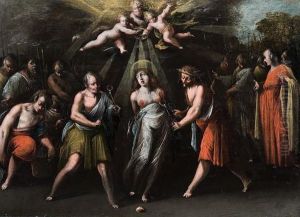Ercole Dell Abate Paintings
Ercole Dell'Abate, also known as Ercole da Ferrara or Ercole dei Fedeli, was an Italian painter of the Renaissance period, born in the years 1509 or 1510 in Ferrara, Italy. Although not widely recognized today, he was an important artist of the Ferrarese school, which flourished in the 16th century under the patronage of the House of Este. His work is often associated with the Mannerist style, which evolved from the High Renaissance and is characterized by elongated forms, complex composition, and an emphasis on style and technique over the naturalistic representation.
Ercole was the son of Pandolfo Dell'Abate, also a painter, and he was initially trained by his father. Later, he became a pupil of the prominent Ferrarese painter Dosso Dossi, who was court painter to the Este family. Under Dossi's guidance, Ercole developed his skills and was influenced by his master's rich color palette and imaginative landscapes. Ercole Dell'Abate's oeuvre includes religious compositions, mythological scenes, and portraits, although only a few of his works have been firmly attributed to him. This is partly due to the scarcity of signed or documented paintings by the artist.
During his career, Ercole worked for the Este court and also received commissions from churches and confraternities. He collaborated with other artists, which was common in the period, and his work was often overshadowed by the dominant figures of the time like Titian and Tintoretto. Ercole's contributions to the art world were nonetheless significant, especially in the context of the Ferrarese school.
Ercole Dell'Abate passed away in 1563. While his legacy is not as prominent as some of his contemporaries, his work provides a valuable insight into the Mannerist movement in Northern Italy. His paintings are characterized by a certain grace and decorative quality, and they reflect the transition from the balanced harmony of the High Renaissance to the more expressive and dynamic approach of Mannerism. Today, his works can be found in various Italian museums and galleries, contributing to the rich tapestry of Renaissance art history.
